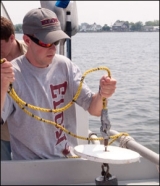Eight students will be presenting the summer work at the Ocean Sciences Meeting in March 2022!
Brett Schuchardt, Elon University
Class Year:
2011Mentor:
Carys Mitchelmore, Ph.D.Project Title:
Acute Toxic Effects of Corexit 9500 on Larval Blue Crab, Callinectus sapidus, Life Stage
Abstract:
Oil spills frequently pollute marine ecosystems and necessitate a quick and timely response for effective cleanup. Recent cleanup efforts have shifted toward chemical cleanup with the addition of dispersants as an effective method of dispersing the spilled oil. However, these chemicals still threaten the health and survivorship of marine organisms and acute toxicity testing has been developed to quantify the toxicity of chemicals. No life stage of blue crab has been acutely tested with the most commonly used dispersant, Corexit 9500 (Deepwater Horizon). 48 hour static acute toxicity tests were performed on blue crab life stages zoea 3, 4, 5, 6, 8, megalopa and juvenile and LC50 values were calculated using probit analysis. Preliminary results suggest that Corexit 9500 was found to be most toxic to zoea stages 3-4 and was less toxic as age progressed to juveniles. An anomaly was found in zoea 4-5 which had a greater LC50 than zoea 5-6 due to changes in water and salinity conditions creating a threshold and non-dose-dependent pattern of mortality. Issues including control survivorship and blue crab aggression were encountered, and future blue crab experiments are necessary to accurately quantify the toxicity of Corexit 9500 to each blue crab life stage. This information can then be used for chemical companies to develop less toxic yet effective dispersants to treat future oil spills.







































